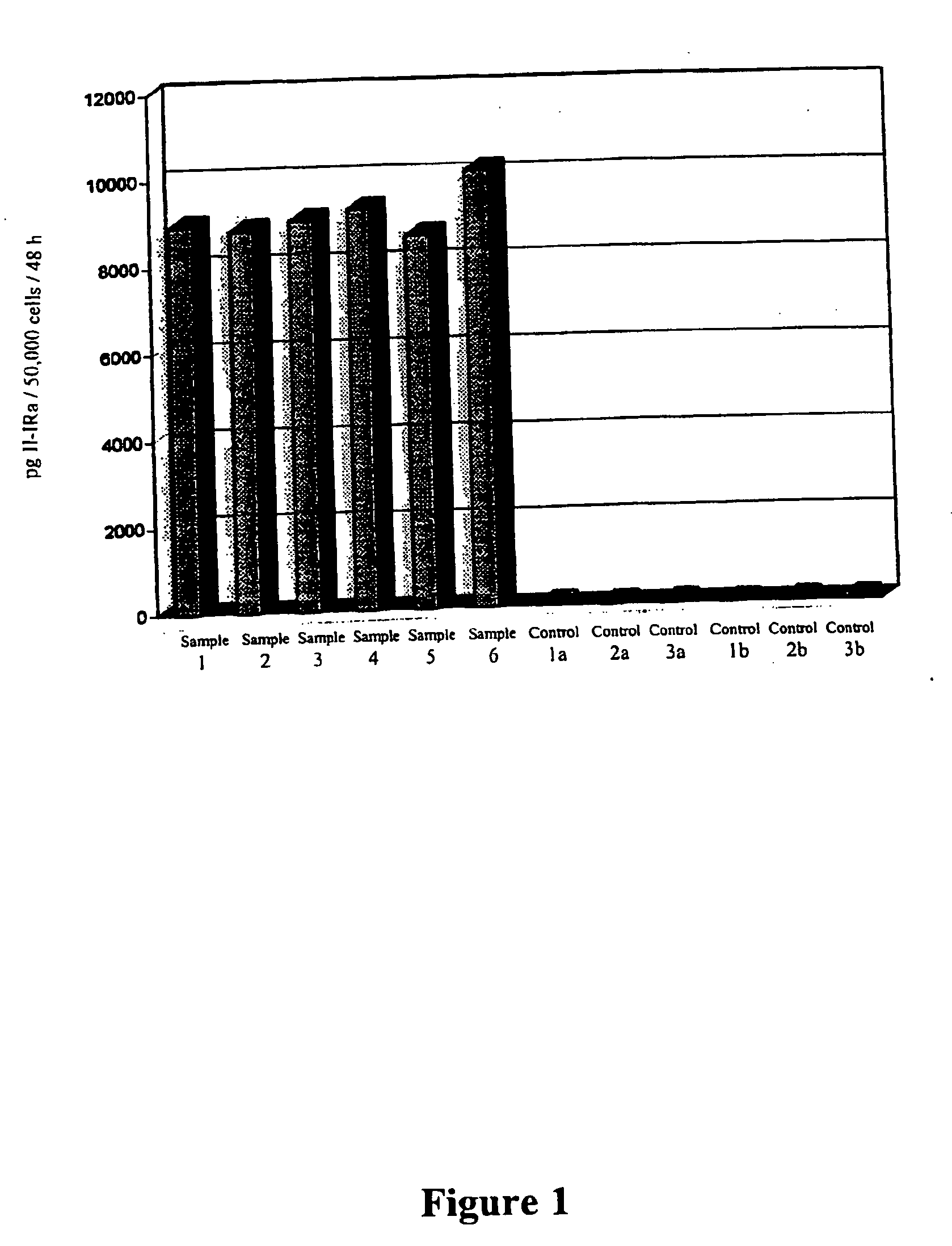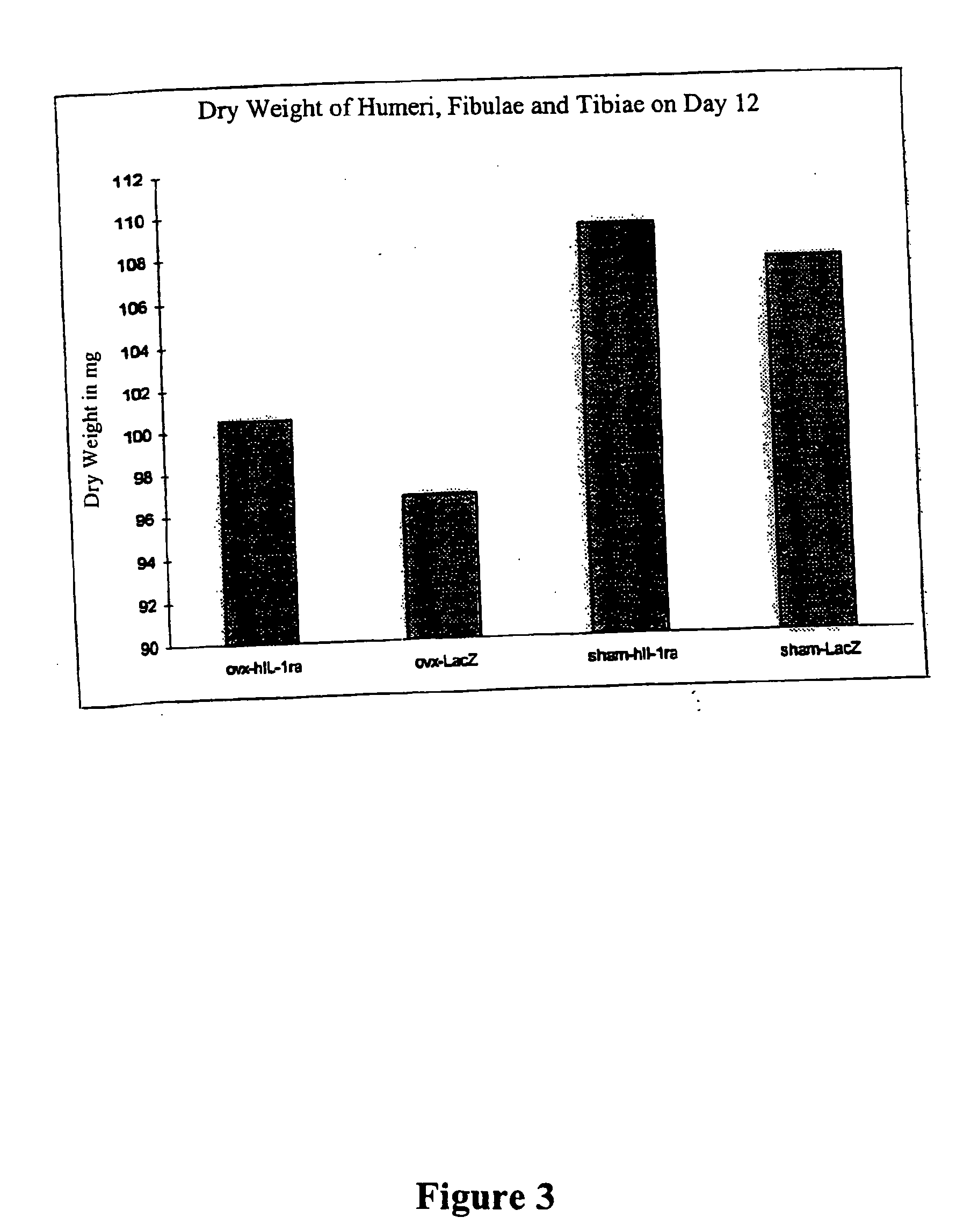Viral and non-viral vectors as vehicles for delivering transgenes for treating bone pathologies
a transgene and bone pathology technology, applied in the direction of dsdna viruses, drug compositions, animal repellents, etc., can solve the problems of large bone defect, bone formation and turnover defect, and defect in bone turnover/repair system
- Summary
- Abstract
- Description
- Claims
- Application Information
AI Technical Summary
Benefits of technology
Problems solved by technology
Method used
Image
Examples
example 1
In Vitro Evaluation of an Osteoporosis Therapy with Retroviral Vectors on the Basis of Human Osteoblastic Cell Populations
A. Materials and Methods
[0060] Human Spongy Bone Isolation:
[0061] Human spongy bone was obtained from informed patients with therapeutic radial or ulnar resection osteotomy. Cells of arthritic femoral heads, often affected by necrotic changes, were difficult to cultivate and had only a short survival time in vitro.
[0062] Isolation of Cells:
[0063] After removal of the cortical parts, the remaining spongy bone was cut into pieces of about 1 mm3 and then cultured. Fragments of residual cortical parts were treated overnight with 0.1% collagenase (Seromed, Berlin) in 25 cm3 culture flasks (Nunc, Denmark). Thereupon the collagen solution was eliminated and the spongiosa fragments were washed 3 times with phosphate buffered saline (PBS; Seromed, Berlin). In this way the connective tissue cells released by the collagen digestion were quantitatively removed. The bon...
example 2
Use of Adenoviral Vectors for Developing a Therapy of Estrogen-Deficiency Induced Osteoporosis in the Balb / C Mouse Model
A. Materials and Methods
[0082] The basis of these experiments was the well-known knowledge that estrogen deficiency leads to activation of osteoclasts by systemic increase of the cytokines interleukin-1 and TNFs, which, through increased osseous resorption, causes generalized bone mass loss. The theory behind the experiments evaluating an osteoporosis therapy on the Balb / C mouse is that, as is known, ovarectomy is followed by generalized bone mass loss which reaches its maximum after about two weeks. See Kishi et al., Bone 22:515-22 (1998). At the time of the experiments all experimental animals were 6 weeks old. A total of five different experimental series was carried out.
[0083] The urinary excretion of deoxypyridinoline crosslinks after ovarectomy (OVX) and after sham ovarectomy was measured after 2 days. The analysis of crosslinks was done by means of the co...
example 3
Treatment of Bone Defects in New Zealand Rabbits
A. Material and Methods
[0093] Animals:
[0094] White female New Zealand rabbits older than 6 months and weighing from 4.3 to 5 kg were used in this study. In all animals, surgical defects were produced in the femur in such a way (as described below) that, without treatment, these defects did not heal after 9 weeks.
[0095] Surgical Procedure:
[0096] After introduction of general anesthesia with ketamine hydrochloride (Ketaject®) (40 mg / kg / M) and xylasin (Xylaject®) (3 mg / kg / M) is. m., both femura of the rabbit were shaved, disinfected with isopropyl alcohol and prepared in a sterile manner. A general anesthesia was introduced with the use of Isofluran 0.8 to 1.5% (AErrane®)) supplemented with 50 to 100% oxygen and 50% dinitrogen oxide. Additional local anesthesia with 2% lidocaine was applied, while the periosteum was detached from the femora, since this procedure caused movements of the rabbits even under general anesthesia. This was...
PUM
| Property | Measurement | Unit |
|---|---|---|
| temperature | aaaaa | aaaaa |
| time | aaaaa | aaaaa |
| pH | aaaaa | aaaaa |
Abstract
Description
Claims
Application Information
 Login to View More
Login to View More - R&D
- Intellectual Property
- Life Sciences
- Materials
- Tech Scout
- Unparalleled Data Quality
- Higher Quality Content
- 60% Fewer Hallucinations
Browse by: Latest US Patents, China's latest patents, Technical Efficacy Thesaurus, Application Domain, Technology Topic, Popular Technical Reports.
© 2025 PatSnap. All rights reserved.Legal|Privacy policy|Modern Slavery Act Transparency Statement|Sitemap|About US| Contact US: help@patsnap.com



